

What is it?
The humerus is the longest bone in the arm. It is articulated with the scapula by the shoulder, ulna, and the radius in the elbow joint. The most common injury of this bone is a humerus fracture. This mainly affects the elderly and young people. Humerus fractures can be classified by the area affected: the upper, centre, or lower section.

Prognosis
Recovery will depend on the following criteria:
There are other factors that can slow down recovery:
What are the symptoms?
Humerus fracture symptoms tend to be immediately noticeable, as there is often a loud snap or crack which is often an indication that the arm is fractured. There are other symptoms, including:
If the patient is in a lot of pain and cannot use their arm, medical help should be sought as soon as possible. Delaying diagnosis and treatment can lead to poor healing.
Medical tests
X-rays are used to diagnose humerus fractures. This can help determine the extent of the injury, locate the exact location of the fracture, and see if it has affected a nearby joint. The doctor may order a CT scan in order to get a more detailed image.
How can it be prevented?
There are certain sports and conditions that can increase the risk of fracturing the humerus. These include; basketball, rugby, wrestling, football, hockey, snowboarding, or skiing. Osteoporosis, a condition that weakens the bones, or a fall, even from a short distance, can also cause a humerus fracture.
What is the treatment?
There are different treatments for a humerus fracture, the one used will depend on the type of fracture. Treatments include:
Which specialist should I see?
A traumatologist, or orthopaedic specialist treats humerus fractures.
